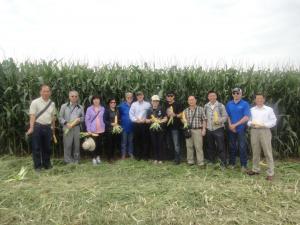The U.S. Grains Council (USGC) will be busy escorting 27 trade teams to the United States this summer, an essential annual outreach used by the Council to accomplish its mission of developing markets, enabling trade and improving lives.
In this week’s Global Update, we asked Kimberly Atkins, USGC director of global programs, to expound on USGC trade teams and programs. Watch for more about USGC trade teams in future editions of Global Update and local ag press.
Q: What are trade teams and their purpose?
Atkins: One of the strengths of the Council is our ability to connect buyers and sellers. The Council’s growers and staff serve as trade ambassadors providing opportunities for both our members and our overseas customers to make new connections and build their businesses.
A majority of USGC-sponsored trade teams coming here to the United States are composed of targeted buyers and end-users of feed grains and their co-products. In addition, the Council often hosts teams made up of policy makers, government regulators and media.
Once they arrive in the United States, the trade teams have the opportunity to get a firsthand look at the quality, production and U.S. export system for corn, barley, sorghum and their co-products. Trade teams typically learn about modern farming practices, sustainability and the role of biotechnology. Teams also visit grain and livestock farms, and tour country elevators, river facilities, ethanol plants and export elevators.
Q: Why are trade teams important to fulfilling the Council’s mission?
Atkins: One of the core values of the Council is to develop strong partnerships and build global connections. As the trade teams travel throughout the United States they build relationships with U.S. corn, barely and sorghum farmers and agribusinesses and gain a sense trust in the U.S. production and export systems. They are able to see and hear firsthand the pride that U.S. farmers have in their crops and the investments that they are making to provide a higher quality product to the export market. This understanding that is built between our industry and those team members is critical to growing the global market for U.S. grains.
Q: What kind of trade team programming does the Council have for summer 2015?
Atkins: The Council’s biggest priority is to increase exports of U.S. corn, barley, sorghum and thier co-products. This includes ethanol.
This year, the Council will sponsor a number of trade and technical teams, including three teams that will be attending the World Pork Expo in early June. Throughout the summer, the Council will also host a number of corn, sorghum, barley and distiller’s dried grains with solubles (DDGS) buying teams as well as teams focused on biotechnology education.
In addition, the Council for the first time will be hosting educational and promotional ethanol trade teams. The first will be from Latin America and will participate in the Fuel Ethanol Workshop in Minneapolis as well as a number of additional meetings and site visits.
The Council staff around the world have planned a busy year of market development programs and we deeply appreciate the on-the-ground planning and logistical support of our stakeholders in helping to make these programs successful.
Q: What kind of support does the Council get for trade teams from our members and partners?
Atkins: The funding for these trade teams comes from the U.S. Department of Agriculture’s (USDA’s) Foreign Agricultural Service (FAS) in the form of Foreign Market Development (FMD) and Market Access Program (MAP) funding. These funds are critical for the continued success of our program.
In addition, the Council relies heavily on our members and stakeholders to host these foreign delegations. We very much appreciate the support that we have received in the past and look forward to continued engagement with our stakeholders in the future as we implement these critical market development programs.


